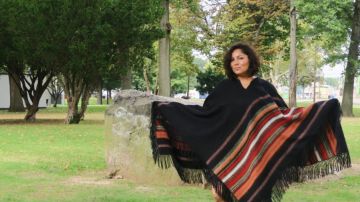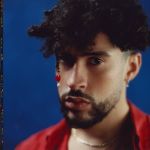Why It Took Years To Embrace My Indigenous Beauty
I used to think I was hella ugly

Photo: Courtesy of Cindy Rodriguez
I used to think I was hella ugly. I hated my cheekbones, wanted a nose job and lied to everyone in high school about not ever wanting to date someone from my own high school because “as if.” I used my sense of humor to hide behind my “ugly.” It was all just a cover up to protect myself, in efforts to reject the guys before they rejected me. While this may seem like your typical “tough teenage years” insecurity story, I would argue that this went way beyond that.
It felt like I was forcefully thrown into the Latino hierarchy where Cuban, Dominican and Puerto Rican girls were at the top because of their small waists and round bottoms. Whereas girls from Peru, Ecuador or Bolivia were seen as less than and at the bottom of the beauty totem pole because of our indigenous features and different body types.
“Too indigenous looking for my blood,” I remember one guy saying to himself as he stood outside his homeroom watching girls walk by. I froze and turned around quickly fearing he would make a comment about me because I knew I looked indigenous. To this day, I cannot believe I let some stupid kid’s comment dictate how I felt about myself. I can’t even remember his name.
I wrote myself off as the chubby funny girl who would always be just one of the guys. I tried to make the best of it but deep down inside all I wanted was to be seen as a beautiful girl.

These feelings were at the foundation of my lack of self-acceptance and self-love. I decided to tackle them head on when I was finally ready to choose me over what anyone else thought “beautiful” really was.
At home, my mother was super supportive, always told me I was beautiful and to never change a thing. But then when I was 13-years old I found out she had a nose job right after I was born.

I found old pictures and immediately noticed the difference. I asked her about it and she said it was because she had a deviated septum but I called bullshit and demanded the truth. I could always tell when my mother was lying.
“Es que no me gustaba mi nariz, hija. Ademas, parecía como una chola,” she finally admitted.
I didn’t know what to say. Because what could I say? My mother and I had the same nose. All kinds of wild thoughts ran through my head:
Does my mom hate my nose?
Does my mom think I’m ugly?
Or that I need surgery?
Does my mom think I look like a “chola”?
But all I could mutter out was, “Yo tambien me puedo hacer cirugía?” to which she said with her eyes wide, “No, no! Tu estas bella. No te hagas nada.” But I didn’t believe her. How could I accept what felt like the biggest nose in the world if the woman I got it from changed hers?
Technically speaking, the word chola means “young girl” but Peruvians use it to refer to indigenous people who live in the Andes, many times in a super derogatory way, to say “you’re ignorant” or “you’re ugly.”
Peruvians (and many other Latinos) have a messed up sense of identity because we were colonized to think that the lighter and the more your features conform to European beauty standards, the more beautiful you are.
My mom said Peruvians would deny their indigenous background but once a few drinks were had, everyone would blast Luis Abanto Morales’ song “Cholo Soy” and denounce their Spanish lineage and embrace their indigenous identity. I witnessed this once while in Peru during a family reunion. I was about 10-years-old and couldn’t believe how quickly everyone changed their tune from “Ese cholo de mierda!” to “Cholo soy, carajo! Soy Peruano!”
These are the side effects of being colonized but I suspect this didn’t do much for my identity as a young Peruvian American growing up in New Jersey having a hard time accepting the body I was born into. I was surrounded by people nipping that and tucking this to fit into the insane beauty standards set by society.
I was 19-years-old and in college when my mother surprised me with a beautiful poncho from her recent trip to Peru. I absolutely loved it. It was black with colored lines at the bottom. But I didn’t have the courage to wear it outside in public. I was scared that I would look too Peruvian or too indigenous. So it collected dust in the back of the closet for years. I would look at it and smile but I wouldn’t dare wear it out. I carried around this shame and I didn’t know what to do with it. I asked myself:
“When am I going to be okay with the way I look?”
Then, I went to Machu Picchu with my sister Yoanna and my Colombian brother-in-law Diego. We went to the mercado for souvenirs where they got ponchos and leather cowboy-like hats. They offered to get me swag but I declined, thinking about the never worn poncho hanging in the back of my closet. What a shame, right?
We went out to dinner and they both wore their gear. From head to toe, they looked like the proudest cholos you’ve ever seen. I admit that I was a little (a lot!) embarrassed to go out with them because everyone stared at us. Even the locals in Cuzco made comments like, “¡Carajo, estos dos parecen más peruanos que yo, ja!”
The best part: my sister and brother-in-law didn’t bat an eye. I was in awe. That was when I decided to leave that shame in Peru.
When I got back, I worked on myself. I journaled like a mad woman. I joined a Women of Color group led by one of the most intelligent, charismatic, and interesting therapists I’ve ever met. She not only helped me accept myself but also love myself. It felt unreal. I almost couldn’t believe it. Chola soy? Hell yea. Bring it because I was starting to fall in love with my indigenous background more than ever. Since then, I’ve been a foreign correspondent for LivinginPeru.com, written candid stories about Latino identity, and even helped launch the Latino vertical at HuffPost.
A few years later, I co-launched a podcast called Morado Lens focused on discussing spirituality, sex and culture that took us to Standing Rock to bring attention to the Dakota Access Pipeline. I knew I might be in a dangerous situation on the front lines showing my support. But what I didn’t know was that I would be accepted, embraced and asked “What tribe are you from?” more times than I could count. I’d never seen so many people in one place who looked like me as I did when I got to the Standing Rock Reservation.
Not only did I come back from Standing Rock prouder than ever of my indigenous identity, but I’ve been on a journey to find out my lineage. While convoluted and mixed. I am mostly indigenous, native to Peru, and I couldn’t be prouder. I even love myself without makeup.

Society’s beauty standards took me on a wild ride, only to come back to the same truth: I am different. I am Peruvian. I am indigenous. I am beautiful. While it might have taken many, many years to get where I am today, I now happily rock my poncho, in public, no longer afraid to look “too Peruvian.”
I hold my poncho close and I’m grateful it waited for me all these years to love it as much as I love myself—high cheekbones and all. With no desire to ever get a nose job and feeling more comfortable in my own olive-colored skin than ever before.


















